Organisational Behaviour Report: Analysis of John Lewis's OB Practices
VerifiedAdded on 2023/01/11
|18
|5275
|46
Report
AI Summary
This report delves into the organisational behaviour (OB) of John Lewis, a prominent British retail company. It examines the impact of OB on company performance and productivity, emphasizing the importance of an ethical work environment. The report covers key factors such as organisational culture, power, politics, teamwork, motivation, and relevant philosophies. It analyses John Lewis's organisational culture using Handy's culture model, exploring power, task, role, and person cultures. It also examines the influence of power, including French and Raven's power types. Furthermore, the report discusses motivational theories, including content theory (Maslow's hierarchy of needs) and process theory (Locke and Latham's theory). The report provides a comprehensive overview of how these factors influence employee behaviour, teamwork, and overall business success, highlighting the importance of these factors for a company's success.
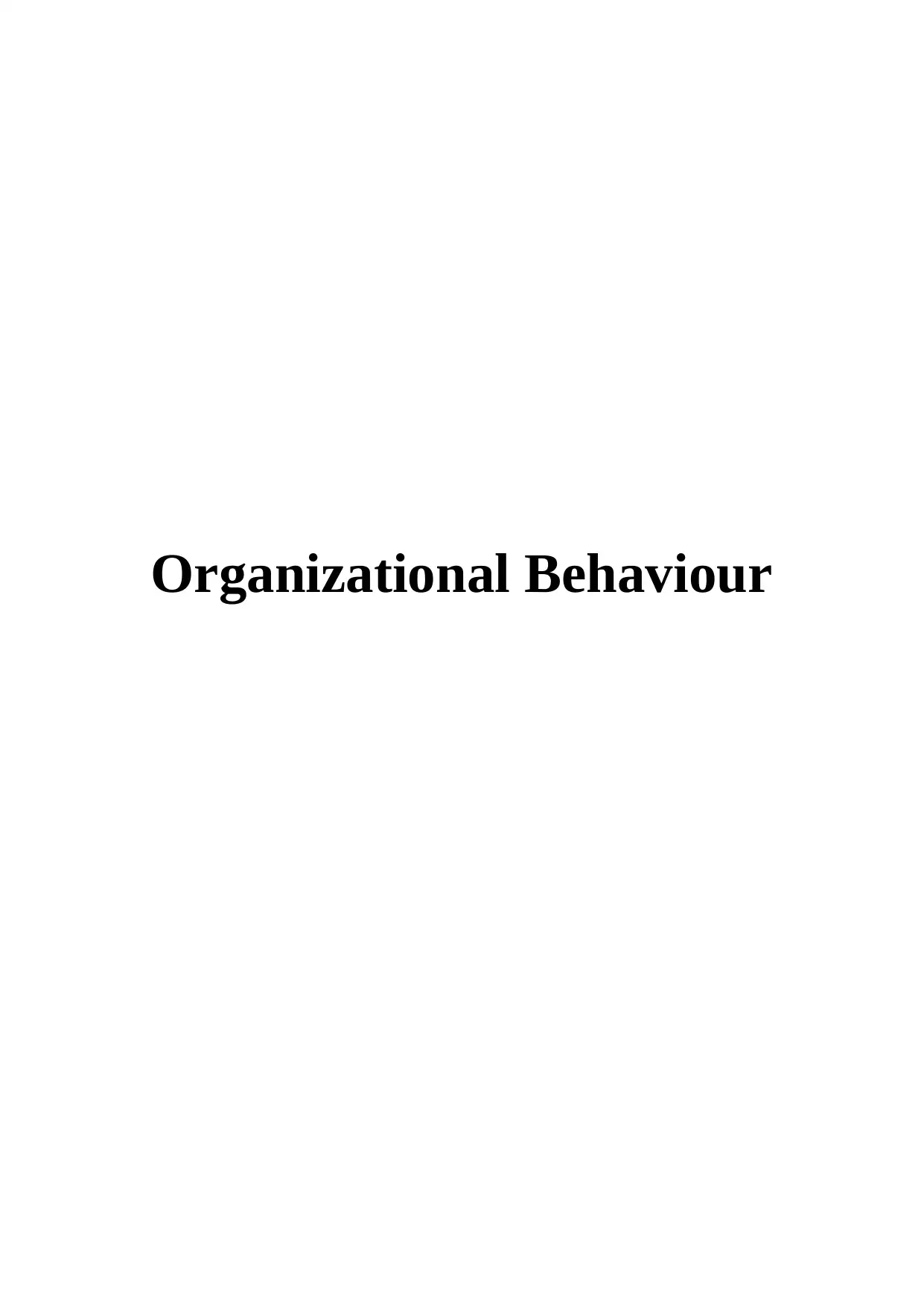
Organizational Behaviour
Paraphrase This Document
Need a fresh take? Get an instant paraphrase of this document with our AI Paraphraser
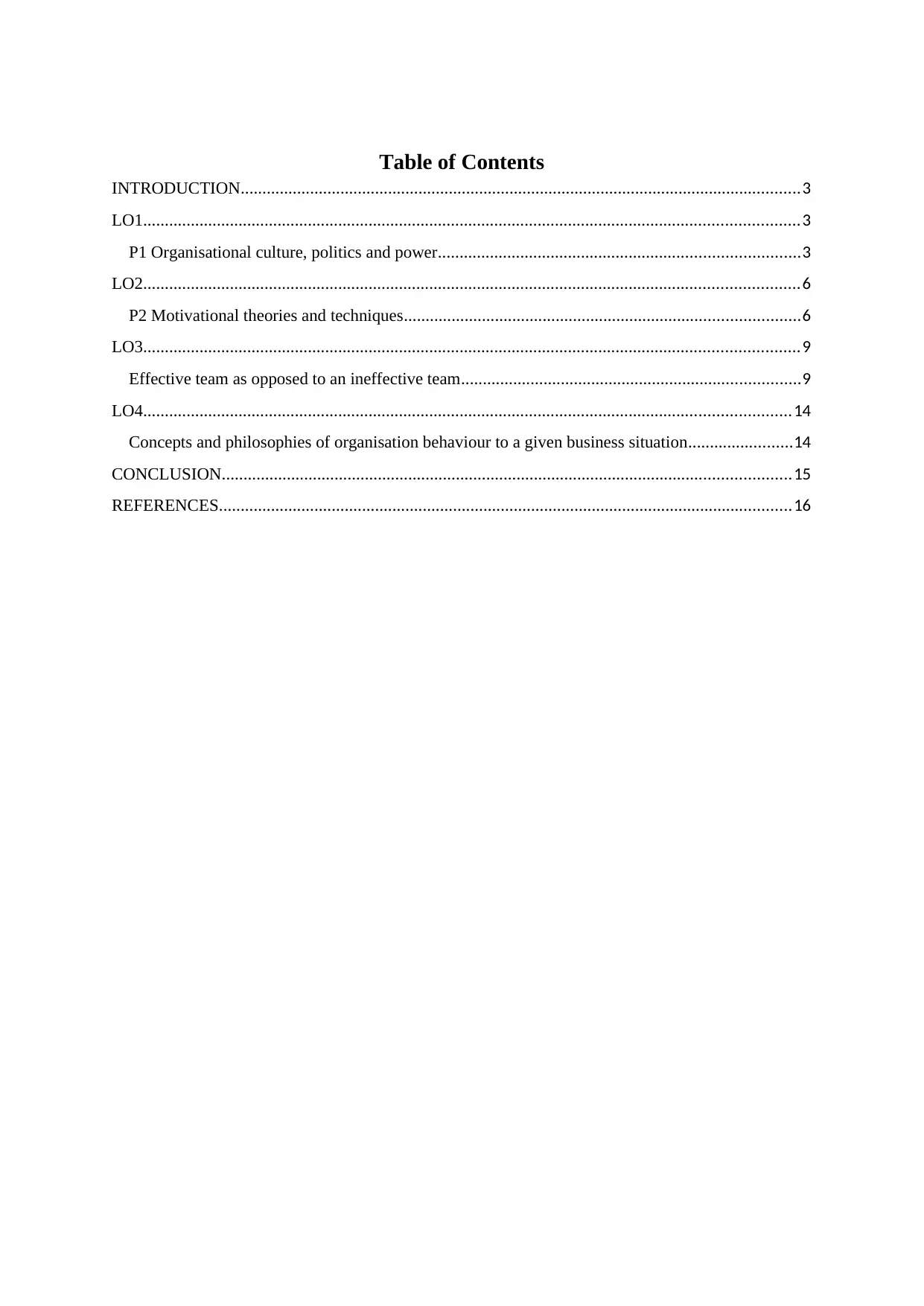
Table of Contents
INTRODUCTION.................................................................................................................................3
LO1.......................................................................................................................................................3
P1 Organisational culture, politics and power...................................................................................3
LO2.......................................................................................................................................................6
P2 Motivational theories and techniques...........................................................................................6
LO3.......................................................................................................................................................9
Effective team as opposed to an ineffective team..............................................................................9
LO4.....................................................................................................................................................14
Concepts and philosophies of organisation behaviour to a given business situation........................14
CONCLUSION...................................................................................................................................15
REFERENCES....................................................................................................................................16
INTRODUCTION.................................................................................................................................3
LO1.......................................................................................................................................................3
P1 Organisational culture, politics and power...................................................................................3
LO2.......................................................................................................................................................6
P2 Motivational theories and techniques...........................................................................................6
LO3.......................................................................................................................................................9
Effective team as opposed to an ineffective team..............................................................................9
LO4.....................................................................................................................................................14
Concepts and philosophies of organisation behaviour to a given business situation........................14
CONCLUSION...................................................................................................................................15
REFERENCES....................................................................................................................................16
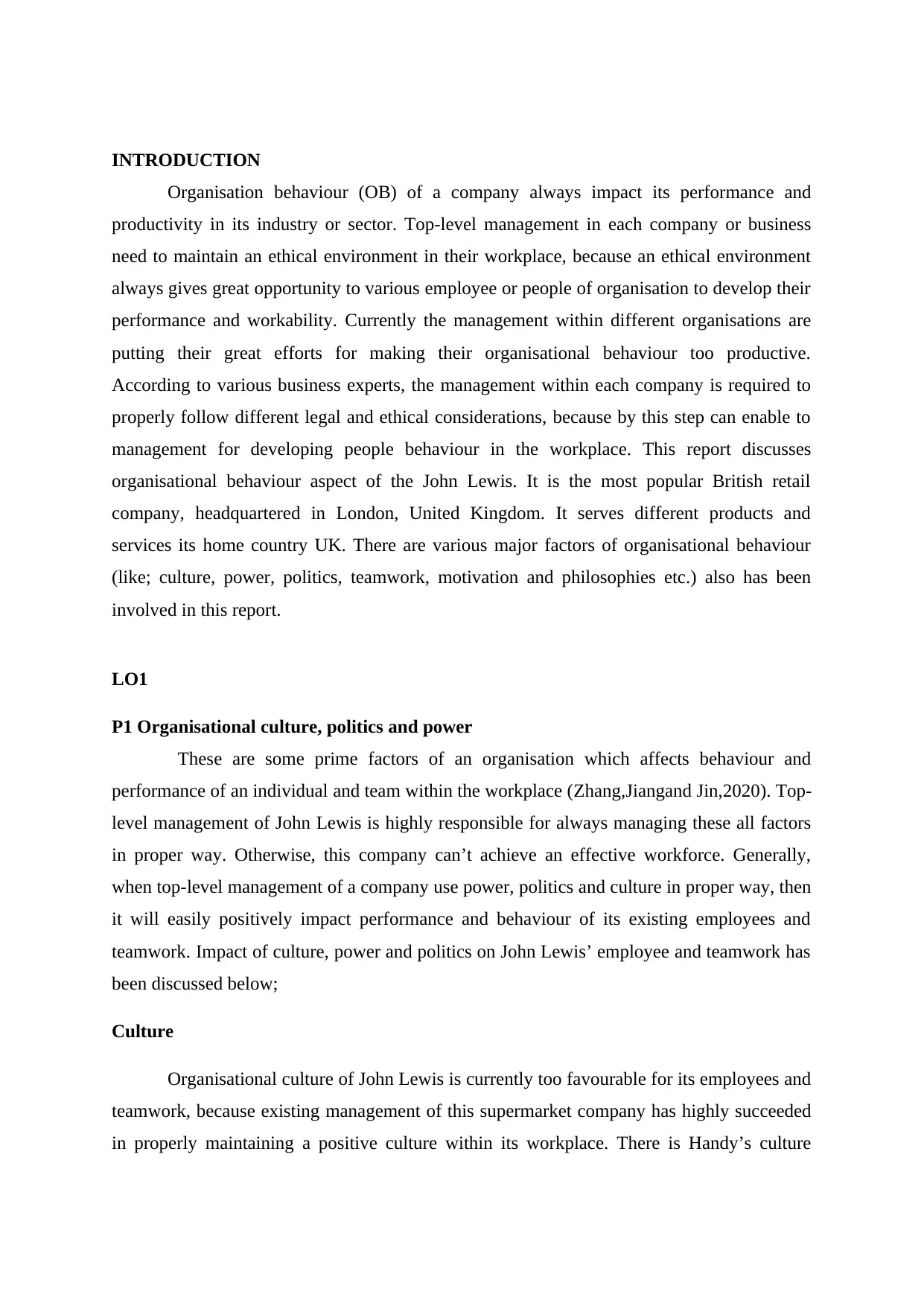
INTRODUCTION
Organisation behaviour (OB) of a company always impact its performance and
productivity in its industry or sector. Top-level management in each company or business
need to maintain an ethical environment in their workplace, because an ethical environment
always gives great opportunity to various employee or people of organisation to develop their
performance and workability. Currently the management within different organisations are
putting their great efforts for making their organisational behaviour too productive.
According to various business experts, the management within each company is required to
properly follow different legal and ethical considerations, because by this step can enable to
management for developing people behaviour in the workplace. This report discusses
organisational behaviour aspect of the John Lewis. It is the most popular British retail
company, headquartered in London, United Kingdom. It serves different products and
services its home country UK. There are various major factors of organisational behaviour
(like; culture, power, politics, teamwork, motivation and philosophies etc.) also has been
involved in this report.
LO1
P1 Organisational culture, politics and power
These are some prime factors of an organisation which affects behaviour and
performance of an individual and team within the workplace (Zhang,Jiangand Jin,2020). Top-
level management of John Lewis is highly responsible for always managing these all factors
in proper way. Otherwise, this company can’t achieve an effective workforce. Generally,
when top-level management of a company use power, politics and culture in proper way, then
it will easily positively impact performance and behaviour of its existing employees and
teamwork. Impact of culture, power and politics on John Lewis’ employee and teamwork has
been discussed below;
Culture
Organisational culture of John Lewis is currently too favourable for its employees and
teamwork, because existing management of this supermarket company has highly succeeded
in properly maintaining a positive culture within its workplace. There is Handy’s culture
Organisation behaviour (OB) of a company always impact its performance and
productivity in its industry or sector. Top-level management in each company or business
need to maintain an ethical environment in their workplace, because an ethical environment
always gives great opportunity to various employee or people of organisation to develop their
performance and workability. Currently the management within different organisations are
putting their great efforts for making their organisational behaviour too productive.
According to various business experts, the management within each company is required to
properly follow different legal and ethical considerations, because by this step can enable to
management for developing people behaviour in the workplace. This report discusses
organisational behaviour aspect of the John Lewis. It is the most popular British retail
company, headquartered in London, United Kingdom. It serves different products and
services its home country UK. There are various major factors of organisational behaviour
(like; culture, power, politics, teamwork, motivation and philosophies etc.) also has been
involved in this report.
LO1
P1 Organisational culture, politics and power
These are some prime factors of an organisation which affects behaviour and
performance of an individual and team within the workplace (Zhang,Jiangand Jin,2020). Top-
level management of John Lewis is highly responsible for always managing these all factors
in proper way. Otherwise, this company can’t achieve an effective workforce. Generally,
when top-level management of a company use power, politics and culture in proper way, then
it will easily positively impact performance and behaviour of its existing employees and
teamwork. Impact of culture, power and politics on John Lewis’ employee and teamwork has
been discussed below;
Culture
Organisational culture of John Lewis is currently too favourable for its employees and
teamwork, because existing management of this supermarket company has highly succeeded
in properly maintaining a positive culture within its workplace. There is Handy’s culture
⊘ This is a preview!⊘
Do you want full access?
Subscribe today to unlock all pages.

Trusted by 1+ million students worldwide
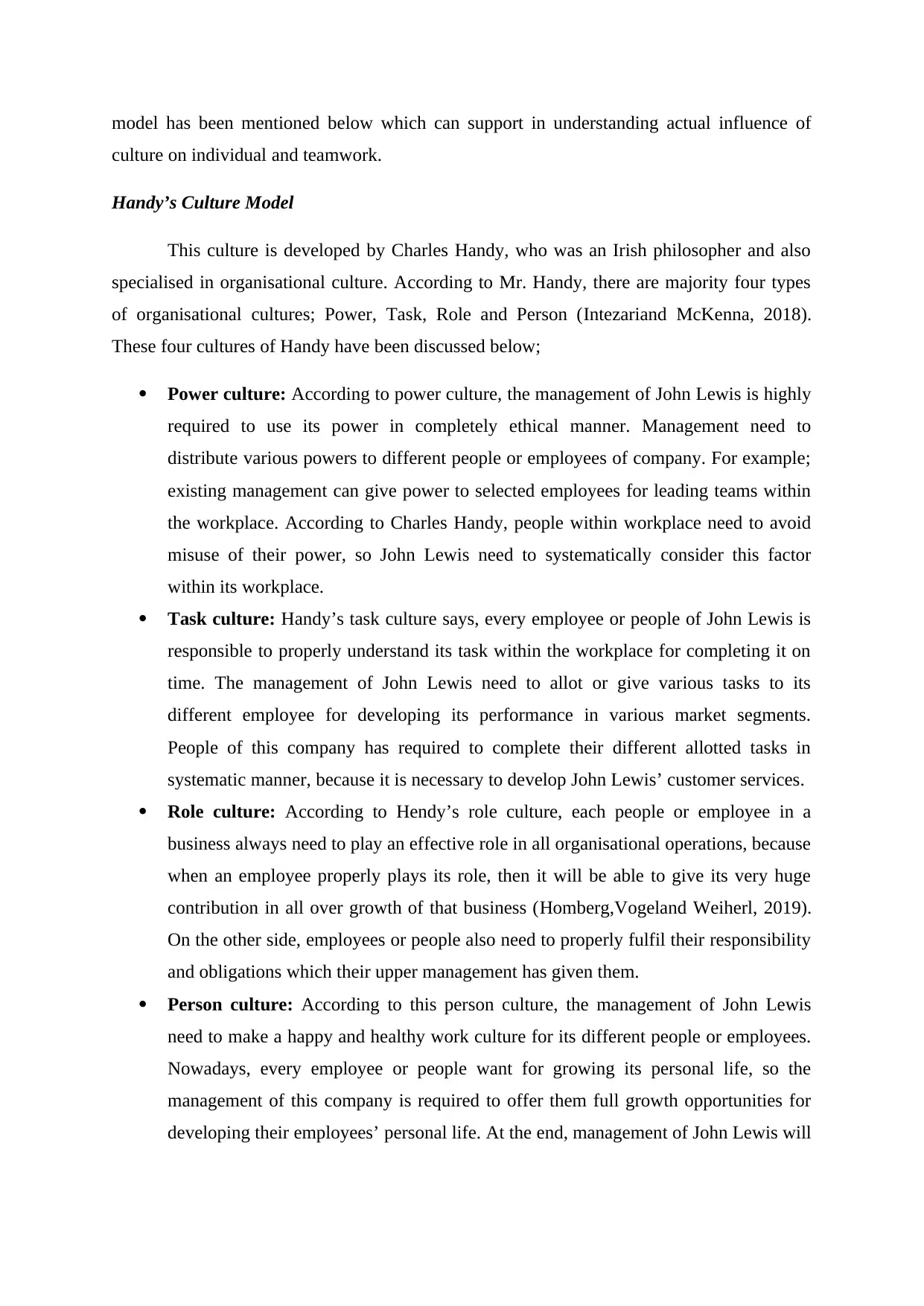
model has been mentioned below which can support in understanding actual influence of
culture on individual and teamwork.
Handy’s Culture Model
This culture is developed by Charles Handy, who was an Irish philosopher and also
specialised in organisational culture. According to Mr. Handy, there are majority four types
of organisational cultures; Power, Task, Role and Person (Intezariand McKenna, 2018).
These four cultures of Handy have been discussed below;
Power culture: According to power culture, the management of John Lewis is highly
required to use its power in completely ethical manner. Management need to
distribute various powers to different people or employees of company. For example;
existing management can give power to selected employees for leading teams within
the workplace. According to Charles Handy, people within workplace need to avoid
misuse of their power, so John Lewis need to systematically consider this factor
within its workplace.
Task culture: Handy’s task culture says, every employee or people of John Lewis is
responsible to properly understand its task within the workplace for completing it on
time. The management of John Lewis need to allot or give various tasks to its
different employee for developing its performance in various market segments.
People of this company has required to complete their different allotted tasks in
systematic manner, because it is necessary to develop John Lewis’ customer services.
Role culture: According to Hendy’s role culture, each people or employee in a
business always need to play an effective role in all organisational operations, because
when an employee properly plays its role, then it will be able to give its very huge
contribution in all over growth of that business (Homberg,Vogeland Weiherl, 2019).
On the other side, employees or people also need to properly fulfil their responsibility
and obligations which their upper management has given them.
Person culture: According to this person culture, the management of John Lewis
need to make a happy and healthy work culture for its different people or employees.
Nowadays, every employee or people want for growing its personal life, so the
management of this company is required to offer them full growth opportunities for
developing their employees’ personal life. At the end, management of John Lewis will
culture on individual and teamwork.
Handy’s Culture Model
This culture is developed by Charles Handy, who was an Irish philosopher and also
specialised in organisational culture. According to Mr. Handy, there are majority four types
of organisational cultures; Power, Task, Role and Person (Intezariand McKenna, 2018).
These four cultures of Handy have been discussed below;
Power culture: According to power culture, the management of John Lewis is highly
required to use its power in completely ethical manner. Management need to
distribute various powers to different people or employees of company. For example;
existing management can give power to selected employees for leading teams within
the workplace. According to Charles Handy, people within workplace need to avoid
misuse of their power, so John Lewis need to systematically consider this factor
within its workplace.
Task culture: Handy’s task culture says, every employee or people of John Lewis is
responsible to properly understand its task within the workplace for completing it on
time. The management of John Lewis need to allot or give various tasks to its
different employee for developing its performance in various market segments.
People of this company has required to complete their different allotted tasks in
systematic manner, because it is necessary to develop John Lewis’ customer services.
Role culture: According to Hendy’s role culture, each people or employee in a
business always need to play an effective role in all organisational operations, because
when an employee properly plays its role, then it will be able to give its very huge
contribution in all over growth of that business (Homberg,Vogeland Weiherl, 2019).
On the other side, employees or people also need to properly fulfil their responsibility
and obligations which their upper management has given them.
Person culture: According to this person culture, the management of John Lewis
need to make a happy and healthy work culture for its different people or employees.
Nowadays, every employee or people want for growing its personal life, so the
management of this company is required to offer them full growth opportunities for
developing their employees’ personal life. At the end, management of John Lewis will
Paraphrase This Document
Need a fresh take? Get an instant paraphrase of this document with our AI Paraphraser

easily affect performance and behaviour of its employee and teamwork in positive
manner.
Power
Power is another major aspect for the John Lewis, in which the management has
distributed different powers to various employee or people of the company (Kodwani,2017).
There is French and Raven’s power types has been mentioned below which can help in
knowing influence of power on performance and behaviour of an individual and teamwork.
French and Raven’s Power Types
According to French and Raven, there are generally five types of power which has
been mentioned below;
Coercive power: Coercive power indicates compulsory power which different people can
implement in their respective existing job role when it’s necessary. For example; the leader
has power for penalising its team members or employees when they not systematically follow
its instructions and guidelines
Reward power: According to this power, few selected people or employees of company has
power to give rewards and appreciation to the high performers of company. Basically,
employees feel valued by the management, when management uses this reward power.
Legitimate Power: There is legitimate power is completely based different social rules,
where the management of John Lewis need to use legitimate power for wellbeing of
employees. Basically, this power promotes business ethics in business environment.
Referent Power: The referent power commonly holds by the upper management at the John
Lewis (Taylor, 2018). With the help of this power, existing management of this supermarket
company is able to monitor, command, and direct it’s all employees in its workplace.
Expert Power: Only such employees or people have expert power in the company who are
expertise and specialist in a particular area. For example; a person within John Lewis is
expert in innovating new strategies or techniques of business, in this situation that person has
expert power.
POLITICS
manner.
Power
Power is another major aspect for the John Lewis, in which the management has
distributed different powers to various employee or people of the company (Kodwani,2017).
There is French and Raven’s power types has been mentioned below which can help in
knowing influence of power on performance and behaviour of an individual and teamwork.
French and Raven’s Power Types
According to French and Raven, there are generally five types of power which has
been mentioned below;
Coercive power: Coercive power indicates compulsory power which different people can
implement in their respective existing job role when it’s necessary. For example; the leader
has power for penalising its team members or employees when they not systematically follow
its instructions and guidelines
Reward power: According to this power, few selected people or employees of company has
power to give rewards and appreciation to the high performers of company. Basically,
employees feel valued by the management, when management uses this reward power.
Legitimate Power: There is legitimate power is completely based different social rules,
where the management of John Lewis need to use legitimate power for wellbeing of
employees. Basically, this power promotes business ethics in business environment.
Referent Power: The referent power commonly holds by the upper management at the John
Lewis (Taylor, 2018). With the help of this power, existing management of this supermarket
company is able to monitor, command, and direct it’s all employees in its workplace.
Expert Power: Only such employees or people have expert power in the company who are
expertise and specialist in a particular area. For example; a person within John Lewis is
expert in innovating new strategies or techniques of business, in this situation that person has
expert power.
POLITICS
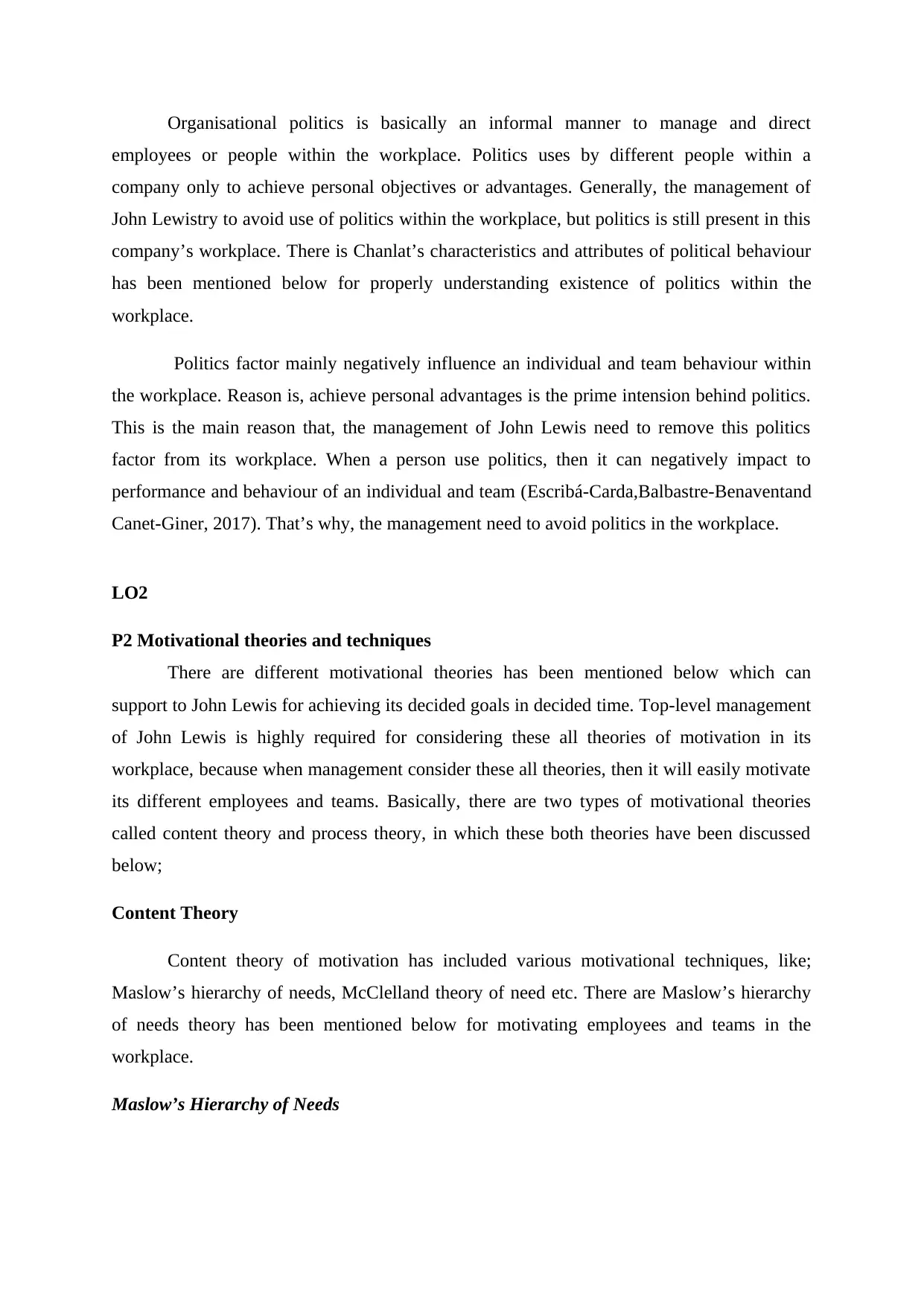
Organisational politics is basically an informal manner to manage and direct
employees or people within the workplace. Politics uses by different people within a
company only to achieve personal objectives or advantages. Generally, the management of
John Lewistry to avoid use of politics within the workplace, but politics is still present in this
company’s workplace. There is Chanlat’s characteristics and attributes of political behaviour
has been mentioned below for properly understanding existence of politics within the
workplace.
Politics factor mainly negatively influence an individual and team behaviour within
the workplace. Reason is, achieve personal advantages is the prime intension behind politics.
This is the main reason that, the management of John Lewis need to remove this politics
factor from its workplace. When a person use politics, then it can negatively impact to
performance and behaviour of an individual and team (Escribá-Carda,Balbastre-Benaventand
Canet-Giner, 2017). That’s why, the management need to avoid politics in the workplace.
LO2
P2 Motivational theories and techniques
There are different motivational theories has been mentioned below which can
support to John Lewis for achieving its decided goals in decided time. Top-level management
of John Lewis is highly required for considering these all theories of motivation in its
workplace, because when management consider these all theories, then it will easily motivate
its different employees and teams. Basically, there are two types of motivational theories
called content theory and process theory, in which these both theories have been discussed
below;
Content Theory
Content theory of motivation has included various motivational techniques, like;
Maslow’s hierarchy of needs, McClelland theory of need etc. There are Maslow’s hierarchy
of needs theory has been mentioned below for motivating employees and teams in the
workplace.
Maslow’s Hierarchy of Needs
employees or people within the workplace. Politics uses by different people within a
company only to achieve personal objectives or advantages. Generally, the management of
John Lewistry to avoid use of politics within the workplace, but politics is still present in this
company’s workplace. There is Chanlat’s characteristics and attributes of political behaviour
has been mentioned below for properly understanding existence of politics within the
workplace.
Politics factor mainly negatively influence an individual and team behaviour within
the workplace. Reason is, achieve personal advantages is the prime intension behind politics.
This is the main reason that, the management of John Lewis need to remove this politics
factor from its workplace. When a person use politics, then it can negatively impact to
performance and behaviour of an individual and team (Escribá-Carda,Balbastre-Benaventand
Canet-Giner, 2017). That’s why, the management need to avoid politics in the workplace.
LO2
P2 Motivational theories and techniques
There are different motivational theories has been mentioned below which can
support to John Lewis for achieving its decided goals in decided time. Top-level management
of John Lewis is highly required for considering these all theories of motivation in its
workplace, because when management consider these all theories, then it will easily motivate
its different employees and teams. Basically, there are two types of motivational theories
called content theory and process theory, in which these both theories have been discussed
below;
Content Theory
Content theory of motivation has included various motivational techniques, like;
Maslow’s hierarchy of needs, McClelland theory of need etc. There are Maslow’s hierarchy
of needs theory has been mentioned below for motivating employees and teams in the
workplace.
Maslow’s Hierarchy of Needs
⊘ This is a preview!⊘
Do you want full access?
Subscribe today to unlock all pages.

Trusted by 1+ million students worldwide
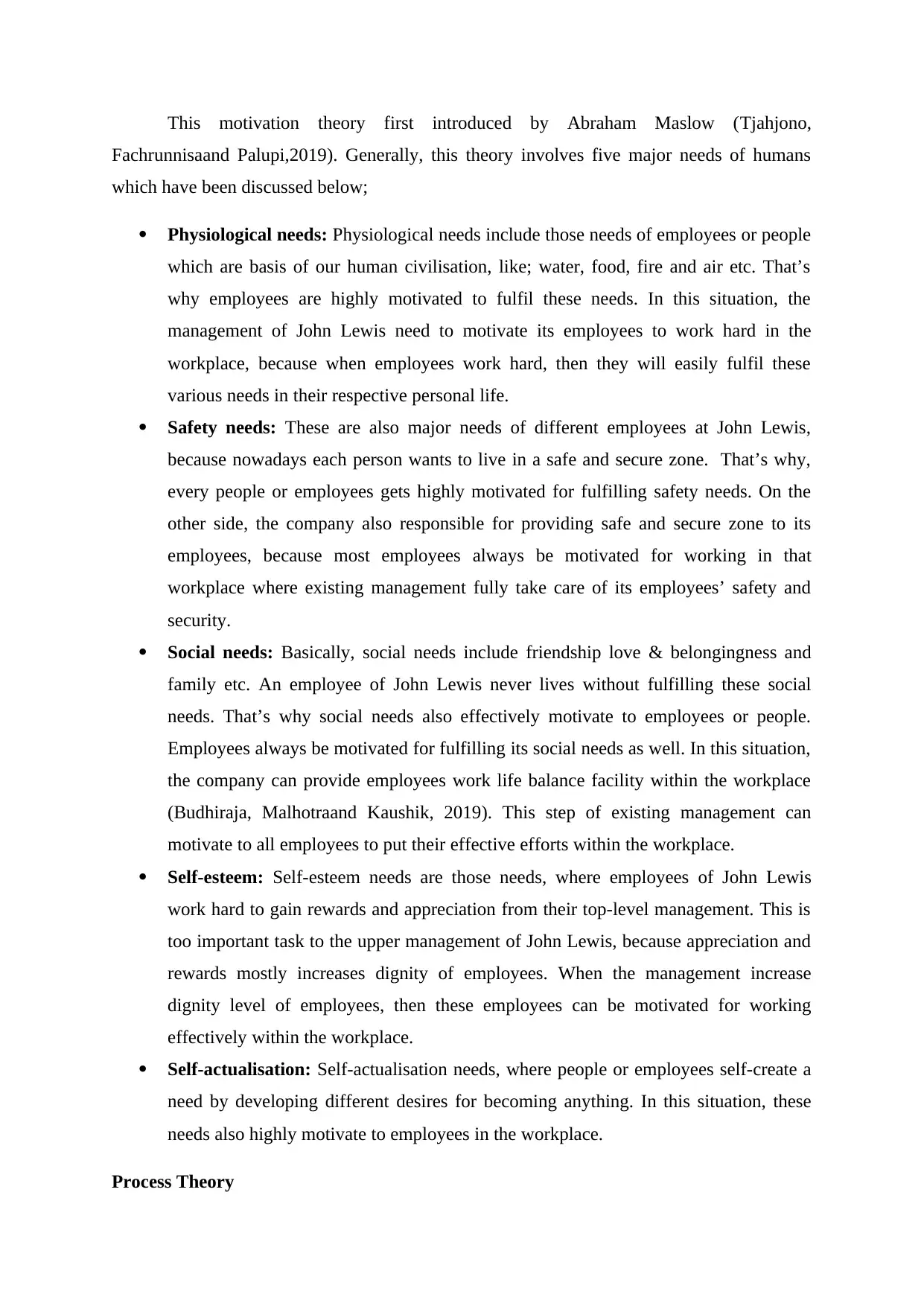
This motivation theory first introduced by Abraham Maslow (Tjahjono,
Fachrunnisaand Palupi,2019). Generally, this theory involves five major needs of humans
which have been discussed below;
Physiological needs: Physiological needs include those needs of employees or people
which are basis of our human civilisation, like; water, food, fire and air etc. That’s
why employees are highly motivated to fulfil these needs. In this situation, the
management of John Lewis need to motivate its employees to work hard in the
workplace, because when employees work hard, then they will easily fulfil these
various needs in their respective personal life.
Safety needs: These are also major needs of different employees at John Lewis,
because nowadays each person wants to live in a safe and secure zone. That’s why,
every people or employees gets highly motivated for fulfilling safety needs. On the
other side, the company also responsible for providing safe and secure zone to its
employees, because most employees always be motivated for working in that
workplace where existing management fully take care of its employees’ safety and
security.
Social needs: Basically, social needs include friendship love & belongingness and
family etc. An employee of John Lewis never lives without fulfilling these social
needs. That’s why social needs also effectively motivate to employees or people.
Employees always be motivated for fulfilling its social needs as well. In this situation,
the company can provide employees work life balance facility within the workplace
(Budhiraja, Malhotraand Kaushik, 2019). This step of existing management can
motivate to all employees to put their effective efforts within the workplace.
Self-esteem: Self-esteem needs are those needs, where employees of John Lewis
work hard to gain rewards and appreciation from their top-level management. This is
too important task to the upper management of John Lewis, because appreciation and
rewards mostly increases dignity of employees. When the management increase
dignity level of employees, then these employees can be motivated for working
effectively within the workplace.
Self-actualisation: Self-actualisation needs, where people or employees self-create a
need by developing different desires for becoming anything. In this situation, these
needs also highly motivate to employees in the workplace.
Process Theory
Fachrunnisaand Palupi,2019). Generally, this theory involves five major needs of humans
which have been discussed below;
Physiological needs: Physiological needs include those needs of employees or people
which are basis of our human civilisation, like; water, food, fire and air etc. That’s
why employees are highly motivated to fulfil these needs. In this situation, the
management of John Lewis need to motivate its employees to work hard in the
workplace, because when employees work hard, then they will easily fulfil these
various needs in their respective personal life.
Safety needs: These are also major needs of different employees at John Lewis,
because nowadays each person wants to live in a safe and secure zone. That’s why,
every people or employees gets highly motivated for fulfilling safety needs. On the
other side, the company also responsible for providing safe and secure zone to its
employees, because most employees always be motivated for working in that
workplace where existing management fully take care of its employees’ safety and
security.
Social needs: Basically, social needs include friendship love & belongingness and
family etc. An employee of John Lewis never lives without fulfilling these social
needs. That’s why social needs also effectively motivate to employees or people.
Employees always be motivated for fulfilling its social needs as well. In this situation,
the company can provide employees work life balance facility within the workplace
(Budhiraja, Malhotraand Kaushik, 2019). This step of existing management can
motivate to all employees to put their effective efforts within the workplace.
Self-esteem: Self-esteem needs are those needs, where employees of John Lewis
work hard to gain rewards and appreciation from their top-level management. This is
too important task to the upper management of John Lewis, because appreciation and
rewards mostly increases dignity of employees. When the management increase
dignity level of employees, then these employees can be motivated for working
effectively within the workplace.
Self-actualisation: Self-actualisation needs, where people or employees self-create a
need by developing different desires for becoming anything. In this situation, these
needs also highly motivate to employees in the workplace.
Process Theory
Paraphrase This Document
Need a fresh take? Get an instant paraphrase of this document with our AI Paraphraser
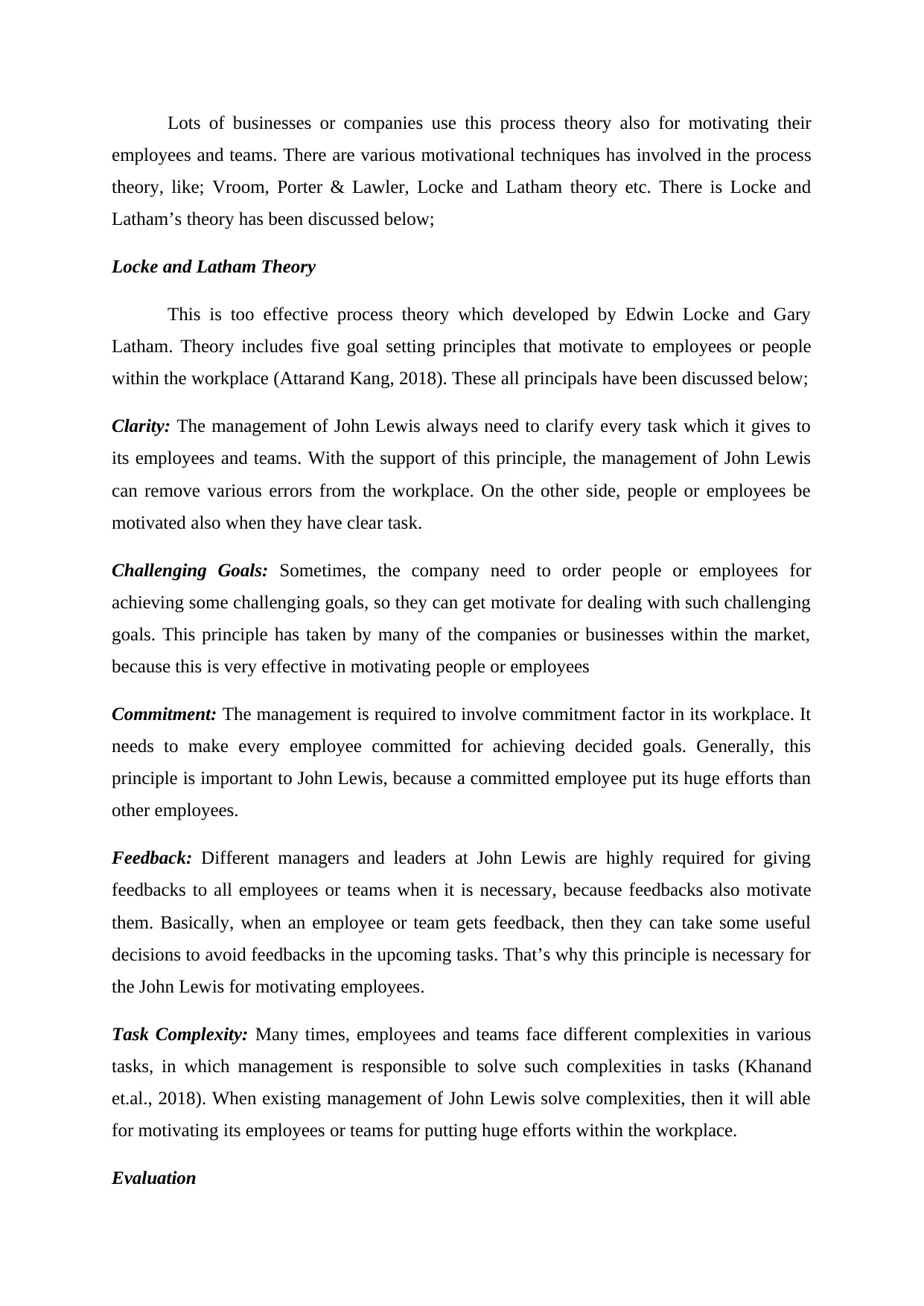
Lots of businesses or companies use this process theory also for motivating their
employees and teams. There are various motivational techniques has involved in the process
theory, like; Vroom, Porter & Lawler, Locke and Latham theory etc. There is Locke and
Latham’s theory has been discussed below;
Locke and Latham Theory
This is too effective process theory which developed by Edwin Locke and Gary
Latham. Theory includes five goal setting principles that motivate to employees or people
within the workplace (Attarand Kang, 2018). These all principals have been discussed below;
Clarity: The management of John Lewis always need to clarify every task which it gives to
its employees and teams. With the support of this principle, the management of John Lewis
can remove various errors from the workplace. On the other side, people or employees be
motivated also when they have clear task.
Challenging Goals: Sometimes, the company need to order people or employees for
achieving some challenging goals, so they can get motivate for dealing with such challenging
goals. This principle has taken by many of the companies or businesses within the market,
because this is very effective in motivating people or employees
Commitment: The management is required to involve commitment factor in its workplace. It
needs to make every employee committed for achieving decided goals. Generally, this
principle is important to John Lewis, because a committed employee put its huge efforts than
other employees.
Feedback: Different managers and leaders at John Lewis are highly required for giving
feedbacks to all employees or teams when it is necessary, because feedbacks also motivate
them. Basically, when an employee or team gets feedback, then they can take some useful
decisions to avoid feedbacks in the upcoming tasks. That’s why this principle is necessary for
the John Lewis for motivating employees.
Task Complexity: Many times, employees and teams face different complexities in various
tasks, in which management is responsible to solve such complexities in tasks (Khanand
et.al., 2018). When existing management of John Lewis solve complexities, then it will able
for motivating its employees or teams for putting huge efforts within the workplace.
Evaluation
employees and teams. There are various motivational techniques has involved in the process
theory, like; Vroom, Porter & Lawler, Locke and Latham theory etc. There is Locke and
Latham’s theory has been discussed below;
Locke and Latham Theory
This is too effective process theory which developed by Edwin Locke and Gary
Latham. Theory includes five goal setting principles that motivate to employees or people
within the workplace (Attarand Kang, 2018). These all principals have been discussed below;
Clarity: The management of John Lewis always need to clarify every task which it gives to
its employees and teams. With the support of this principle, the management of John Lewis
can remove various errors from the workplace. On the other side, people or employees be
motivated also when they have clear task.
Challenging Goals: Sometimes, the company need to order people or employees for
achieving some challenging goals, so they can get motivate for dealing with such challenging
goals. This principle has taken by many of the companies or businesses within the market,
because this is very effective in motivating people or employees
Commitment: The management is required to involve commitment factor in its workplace. It
needs to make every employee committed for achieving decided goals. Generally, this
principle is important to John Lewis, because a committed employee put its huge efforts than
other employees.
Feedback: Different managers and leaders at John Lewis are highly required for giving
feedbacks to all employees or teams when it is necessary, because feedbacks also motivate
them. Basically, when an employee or team gets feedback, then they can take some useful
decisions to avoid feedbacks in the upcoming tasks. That’s why this principle is necessary for
the John Lewis for motivating employees.
Task Complexity: Many times, employees and teams face different complexities in various
tasks, in which management is responsible to solve such complexities in tasks (Khanand
et.al., 2018). When existing management of John Lewis solve complexities, then it will able
for motivating its employees or teams for putting huge efforts within the workplace.
Evaluation

There is a very effective relationship between culture, politics, power and motivation.
Top-level management of John Lewis is required to properly use these all factorsfor
improving performance, behaviour and productivity of its people, employees and teams. If
the management ethically use these all factors, then it will able to take many advantages from
these aspects.
Recommendations
The management at John Lewis has great opportunity for developing it’s all over
performance within the market by properly using culture, politics and power. On the other
side, John Lewis can use various motivational theories for developing performance and
behaviour of an individual and team in the workplace. These all steps will fully develop
productivity of John Lewis within the retail industry.
LO3
Effective team as opposed to an ineffective team
Teams are defined as bunch of people working to achieve the common targets.
Differences between an effective team and an ineffective team can be summarises in the
following points.
Point of difference Effective team Ineffective team
Meaning Effective team are defined as
all such teams that are able to
achieve the objectives behind
formation of such teams.
On the basis of the
productivity a team is
defined as an effective team.
Ineffective team is defined as
such team who couldn’t cope
up with the objectives behind
formation of such team.
On the basis of lack of
productivity a team is
defined as an ineffective
team.
Productivity Productivity is the work
efficiency of the team.
Productivity is denoted as
achieving the objectives
behind formation of the team
(Simmonds, 2018).
Due to lack of productivity a
team is denoted as an
ineffective team..
Teams that are not able to
achieve the goals in the set
time spam is call as
Top-level management of John Lewis is required to properly use these all factorsfor
improving performance, behaviour and productivity of its people, employees and teams. If
the management ethically use these all factors, then it will able to take many advantages from
these aspects.
Recommendations
The management at John Lewis has great opportunity for developing it’s all over
performance within the market by properly using culture, politics and power. On the other
side, John Lewis can use various motivational theories for developing performance and
behaviour of an individual and team in the workplace. These all steps will fully develop
productivity of John Lewis within the retail industry.
LO3
Effective team as opposed to an ineffective team
Teams are defined as bunch of people working to achieve the common targets.
Differences between an effective team and an ineffective team can be summarises in the
following points.
Point of difference Effective team Ineffective team
Meaning Effective team are defined as
all such teams that are able to
achieve the objectives behind
formation of such teams.
On the basis of the
productivity a team is
defined as an effective team.
Ineffective team is defined as
such team who couldn’t cope
up with the objectives behind
formation of such team.
On the basis of lack of
productivity a team is
defined as an ineffective
team.
Productivity Productivity is the work
efficiency of the team.
Productivity is denoted as
achieving the objectives
behind formation of the team
(Simmonds, 2018).
Due to lack of productivity a
team is denoted as an
ineffective team..
Teams that are not able to
achieve the goals in the set
time spam is call as
⊘ This is a preview!⊘
Do you want full access?
Subscribe today to unlock all pages.

Trusted by 1+ million students worldwide
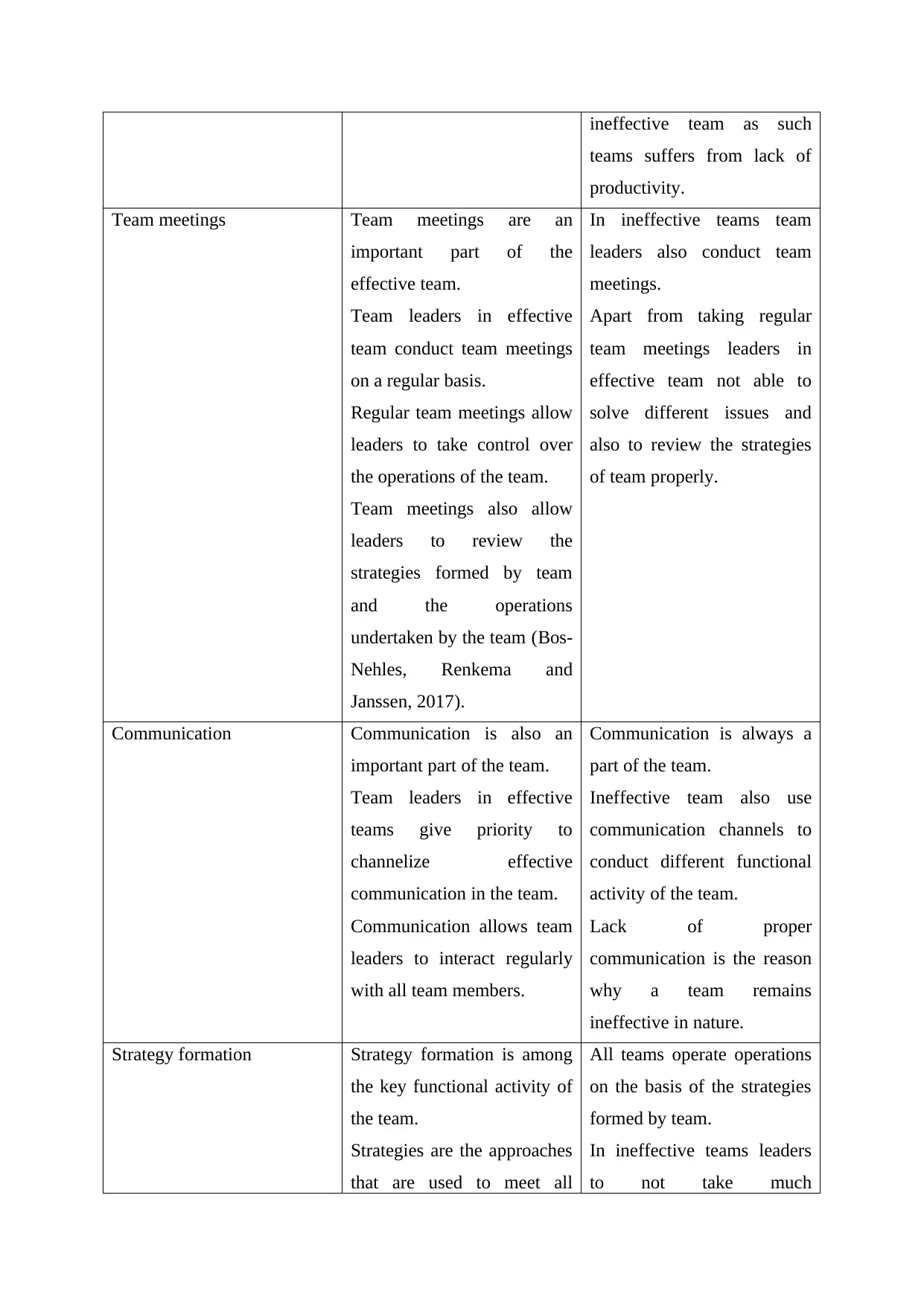
ineffective team as such
teams suffers from lack of
productivity.
Team meetings Team meetings are an
important part of the
effective team.
Team leaders in effective
team conduct team meetings
on a regular basis.
Regular team meetings allow
leaders to take control over
the operations of the team.
Team meetings also allow
leaders to review the
strategies formed by team
and the operations
undertaken by the team (Bos-
Nehles, Renkema and
Janssen, 2017).
In ineffective teams team
leaders also conduct team
meetings.
Apart from taking regular
team meetings leaders in
effective team not able to
solve different issues and
also to review the strategies
of team properly.
Communication Communication is also an
important part of the team.
Team leaders in effective
teams give priority to
channelize effective
communication in the team.
Communication allows team
leaders to interact regularly
with all team members.
Communication is always a
part of the team.
Ineffective team also use
communication channels to
conduct different functional
activity of the team.
Lack of proper
communication is the reason
why a team remains
ineffective in nature.
Strategy formation Strategy formation is among
the key functional activity of
the team.
Strategies are the approaches
that are used to meet all
All teams operate operations
on the basis of the strategies
formed by team.
In ineffective teams leaders
to not take much
teams suffers from lack of
productivity.
Team meetings Team meetings are an
important part of the
effective team.
Team leaders in effective
team conduct team meetings
on a regular basis.
Regular team meetings allow
leaders to take control over
the operations of the team.
Team meetings also allow
leaders to review the
strategies formed by team
and the operations
undertaken by the team (Bos-
Nehles, Renkema and
Janssen, 2017).
In ineffective teams team
leaders also conduct team
meetings.
Apart from taking regular
team meetings leaders in
effective team not able to
solve different issues and
also to review the strategies
of team properly.
Communication Communication is also an
important part of the team.
Team leaders in effective
teams give priority to
channelize effective
communication in the team.
Communication allows team
leaders to interact regularly
with all team members.
Communication is always a
part of the team.
Ineffective team also use
communication channels to
conduct different functional
activity of the team.
Lack of proper
communication is the reason
why a team remains
ineffective in nature.
Strategy formation Strategy formation is among
the key functional activity of
the team.
Strategies are the approaches
that are used to meet all
All teams operate operations
on the basis of the strategies
formed by team.
In ineffective teams leaders
to not take much
Paraphrase This Document
Need a fresh take? Get an instant paraphrase of this document with our AI Paraphraser

responsibilities associated
with the team.
With the support of strategies
team leaders achieves all
objectives of the team.
Team leaders in effective
team also involve all team
members while formation of
functional strategies of the
team.
Team leaders also review the
strategies of team on a
regular basis so that proper
changes can be implemented
in the strategies.
involvement of team
members while formation of
strategies for conducting
different functional activity
of team (Escrig-Tena and
et.al., 2018).
As the team leaders do not
take suggestions from team
members which also remove
the strategic development in
the team.
Due to lack of collaborations
of team members leaders not
able to make relevant
changes in the strategies.
Flexibility Flexibility is among the key
strength of effective team.
Team leaders involve
different members in team on
the basis of the needs and
demands of the operations
undertaken by team.
Team leaders try to keep
flexibility in the team so that
all challenges can be faced
by team members.
Ineffective team do not give
much priority to flexibility
while formation of the team.
Lack of flexibility in team
also becomes one of the
major reason why a team is
emerges as an ineffective
team.
Clarity of individual role At the time of the formation
of team leaders in team make
clarify all members about the
individual roles and
responsibilities in the team.
As the team leaders clarify
all individual role and
In ineffective team also
leaders make clear individual
roles at the initial stage of the
team formation.
Apart from role clarification
team members do not get to
perform the operations in
with the team.
With the support of strategies
team leaders achieves all
objectives of the team.
Team leaders in effective
team also involve all team
members while formation of
functional strategies of the
team.
Team leaders also review the
strategies of team on a
regular basis so that proper
changes can be implemented
in the strategies.
involvement of team
members while formation of
strategies for conducting
different functional activity
of team (Escrig-Tena and
et.al., 2018).
As the team leaders do not
take suggestions from team
members which also remove
the strategic development in
the team.
Due to lack of collaborations
of team members leaders not
able to make relevant
changes in the strategies.
Flexibility Flexibility is among the key
strength of effective team.
Team leaders involve
different members in team on
the basis of the needs and
demands of the operations
undertaken by team.
Team leaders try to keep
flexibility in the team so that
all challenges can be faced
by team members.
Ineffective team do not give
much priority to flexibility
while formation of the team.
Lack of flexibility in team
also becomes one of the
major reason why a team is
emerges as an ineffective
team.
Clarity of individual role At the time of the formation
of team leaders in team make
clarify all members about the
individual roles and
responsibilities in the team.
As the team leaders clarify
all individual role and
In ineffective team also
leaders make clear individual
roles at the initial stage of the
team formation.
Apart from role clarification
team members do not get to
perform the operations in
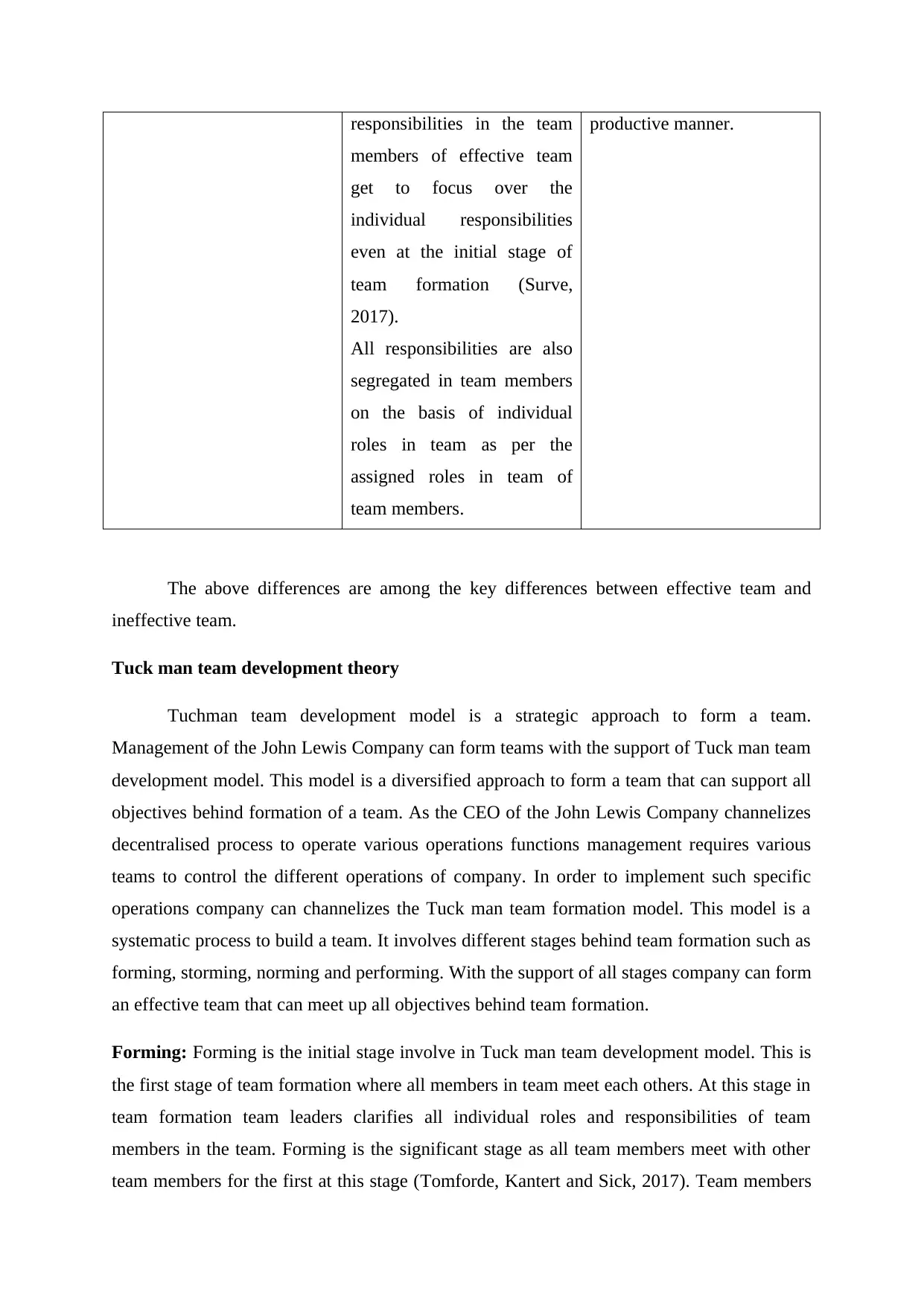
responsibilities in the team
members of effective team
get to focus over the
individual responsibilities
even at the initial stage of
team formation (Surve,
2017).
All responsibilities are also
segregated in team members
on the basis of individual
roles in team as per the
assigned roles in team of
team members.
productive manner.
The above differences are among the key differences between effective team and
ineffective team.
Tuck man team development theory
Tuchman team development model is a strategic approach to form a team.
Management of the John Lewis Company can form teams with the support of Tuck man team
development model. This model is a diversified approach to form a team that can support all
objectives behind formation of a team. As the CEO of the John Lewis Company channelizes
decentralised process to operate various operations functions management requires various
teams to control the different operations of company. In order to implement such specific
operations company can channelizes the Tuck man team formation model. This model is a
systematic process to build a team. It involves different stages behind team formation such as
forming, storming, norming and performing. With the support of all stages company can form
an effective team that can meet up all objectives behind team formation.
Forming: Forming is the initial stage involve in Tuck man team development model. This is
the first stage of team formation where all members in team meet each others. At this stage in
team formation team leaders clarifies all individual roles and responsibilities of team
members in the team. Forming is the significant stage as all team members meet with other
team members for the first at this stage (Tomforde, Kantert and Sick, 2017). Team members
members of effective team
get to focus over the
individual responsibilities
even at the initial stage of
team formation (Surve,
2017).
All responsibilities are also
segregated in team members
on the basis of individual
roles in team as per the
assigned roles in team of
team members.
productive manner.
The above differences are among the key differences between effective team and
ineffective team.
Tuck man team development theory
Tuchman team development model is a strategic approach to form a team.
Management of the John Lewis Company can form teams with the support of Tuck man team
development model. This model is a diversified approach to form a team that can support all
objectives behind formation of a team. As the CEO of the John Lewis Company channelizes
decentralised process to operate various operations functions management requires various
teams to control the different operations of company. In order to implement such specific
operations company can channelizes the Tuck man team formation model. This model is a
systematic process to build a team. It involves different stages behind team formation such as
forming, storming, norming and performing. With the support of all stages company can form
an effective team that can meet up all objectives behind team formation.
Forming: Forming is the initial stage involve in Tuck man team development model. This is
the first stage of team formation where all members in team meet each others. At this stage in
team formation team leaders clarifies all individual roles and responsibilities of team
members in the team. Forming is the significant stage as all team members meet with other
team members for the first at this stage (Tomforde, Kantert and Sick, 2017). Team members
⊘ This is a preview!⊘
Do you want full access?
Subscribe today to unlock all pages.

Trusted by 1+ million students worldwide
1 out of 18
Related Documents
Your All-in-One AI-Powered Toolkit for Academic Success.
+13062052269
info@desklib.com
Available 24*7 on WhatsApp / Email
![[object Object]](/_next/static/media/star-bottom.7253800d.svg)
Unlock your academic potential
Copyright © 2020–2025 A2Z Services. All Rights Reserved. Developed and managed by ZUCOL.





